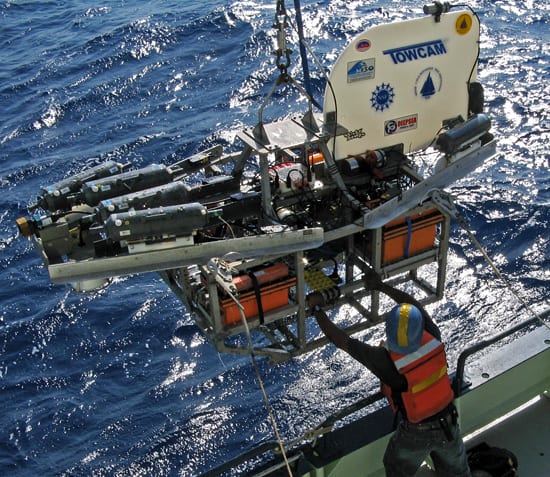Towed Camera System
TowCam is a specially designed digital camera system that photographs the seafloor as it is towed above the ocean bottom behind an oceanographic research vessel. A regular underwater camera would not work in such an extreme environment, where it must take pictures in total blackness, crushing pressure, and freezing temperatures.
The camera system is towed 100 to 300 meters (328 to 984 feet) behind the ship at speeds of 1/4 to 1/2 knot, the equivalent of walking at a leisurely pace. After launch researchers work from the ship's lab, where they “fly” the TowCam about 5 meters (16 feet) above the seafloor. They track its depth and altitude, as well as water temperature, and water clarity, or turbidity. This information comes through a cable that links the TowCam to the ship. The cable also allows scientists to raise and lower the camera if they encounter deeper valleys or large rocks on the seafloor.
Each tow lasts 5 to 7 hours. It can operate night or day; nights are preferred when scientists are using the submersible Alvin for day operations.
TowCam is also equipped to take samples of water and collect rocks from the seafloor.
Learn more about:
» Design & capabilities
» Data analysis
» Frequently asked questions
Additional Information
TowCam information on MISO Facility Website
The intent of the Multidisciplinary Instrumentation in Support of Oceanography (MISO) Facility at WHOI is to provide an adequate pool of commonly used and essential digital imaging equipment and associated sensors and acoustic transponders for various large-scale experiments and programs in the ocean sciences.
TowCam Documentation
General guidelines, safety procedures, operational guidelines and data processing documentation.
Planning for a cruise with TowCam
If you are interested in used the towed camera system for an upcoming cruise, please complete the online form and budget worksheet located on the Multidisciplinary Instrumentation in Support of Oceanography (MISO) Facility Web site.

